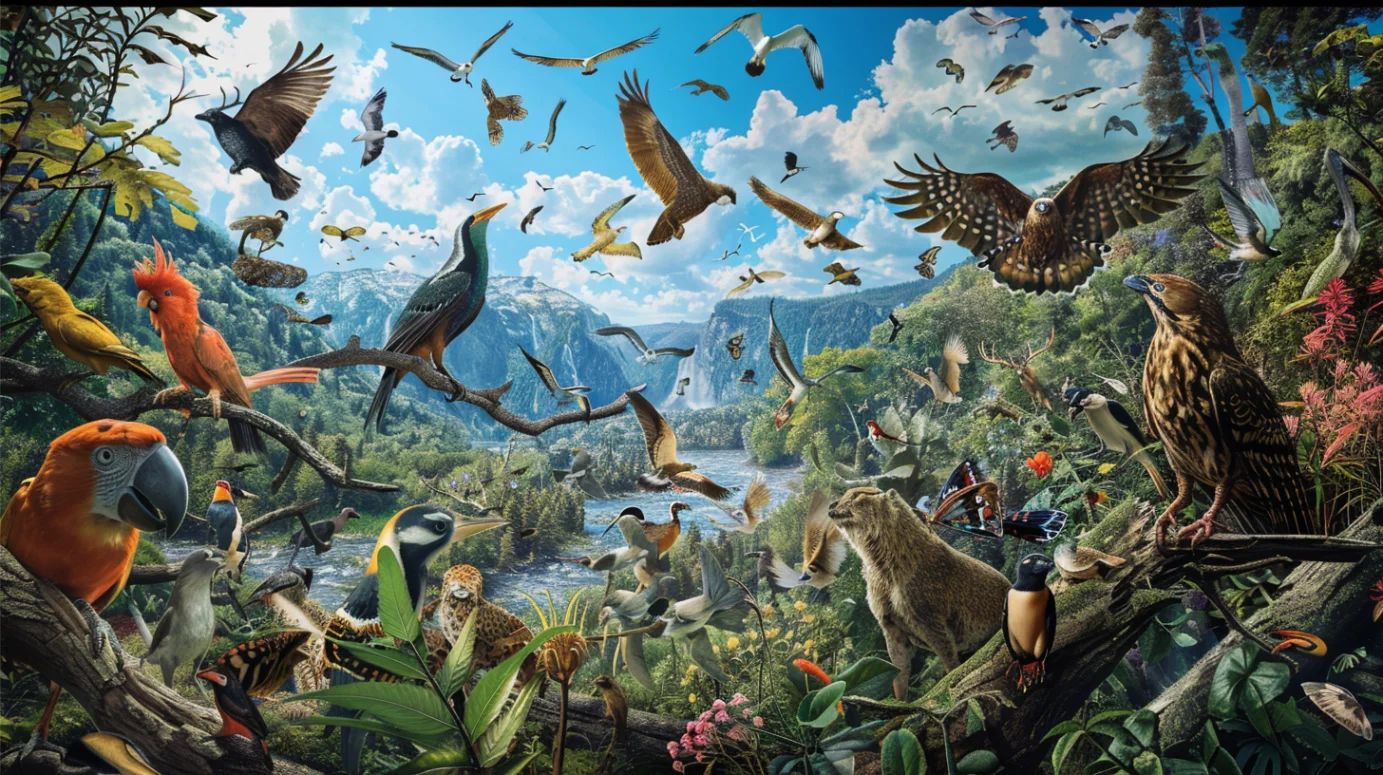The pictures we use in our articles might not show exactly what the words say. We choose these pictures to make you interested in reading more. The pictures work together with the words but don’t take their place. The words still tell you the important facts.
The IUCN Red List is a cornerstone of global conservation efforts, providing vital information about the status of species across our planet. In this post, we'll explore 18 essential facts about the IUCN Red List 1 that highlight its importance in protecting our world's biodiversity. Whether you're passionate about nature or simply curious about wildlife conservation, these facts will deepen your understanding of this crucial resource.
1. Origin and Purpose
The IUCN Red List, short for the International Union for Conservation of Nature's Red List of Threatened Species 2, was established in 1964. Its primary goal is to assess the conservation status and extinction risk of plant and animal species worldwide. This invaluable tool was created to provide a comprehensive, objective framework for evaluating the risk of extinction for thousands of species.
The Red List serves as a wake-up call, highlighting the plight of endangered species and ecosystems. It's not just a list of endangered animals – it covers a wide range of life forms, from tiny insects to towering trees, giving us a holistic view of Earth's biodiversity.
2. Global Indicator
The Red List serves as a global indicator of biodiversity health, helping conservationists, policymakers, and the public understand the state of our planet's ecosystems. It's like a report card for nature, showing us where we're succeeding in conservation efforts and where we need to focus more attention.
This comprehensive database allows scientists and policymakers to track changes in biodiversity over time, identify emerging threats, and measure the effectiveness of conservation actions. It's an essential tool for monitoring progress towards global conservation targets, such as the United Nations Sustainable Development Goals.

3. Comprehensive Database
As of 2023, the IUCN Red List has assessed 150,388 species, providing a wealth of information on their conservation status. This vast database is the result of decades of research and collaboration among scientists, conservationists, and local experts worldwide.
Each species assessment includes detailed information about its distribution, population trends, habitat preferences, and threats. This wealth of data makes the Red List an invaluable resource for researchers, conservationists, and policymakers working to protect biodiversity.
4. Classification System
The IUCN Red List uses nine categories to classify species based on their risk of extinction. These categories are:
This classification system provides a clear, standardized way to communicate the conservation status of species. It allows for quick identification of species at highest risk and helps prioritize conservation efforts.
5. Threatened Species
The categories "Critically Endangered," "Endangered," and "Vulnerable" are collectively referred to as "threatened" species. These categories represent different levels of extinction risk, with Critically Endangered species facing an extremely high risk of extinction in the wild.
Understanding which species fall into these categories is crucial for directing conservation resources and efforts. It helps conservationists focus on the most vulnerable species and develop targeted strategies to protect them.
6. Assessment Criteria
The IUCN uses five main criteria to evaluate species:
These criteria ensure that assessments are based on solid scientific evidence and can be consistently applied across different species and regions. They take into account various factors that influence a species' risk of extinction, providing a comprehensive evaluation of its conservation status.
7. Scientific Rigor
The IUCN Red List employs a meticulous scientific process to evaluate species' conservation status, involving in-depth analysis of population trends, geographical range, and prevailing threats. This process involves collecting and analyzing data from various sources, including field studies, scientific literature, and expert knowledge.
The assessment process is rigorous and peer-reviewed, ensuring that the information provided in the Red List is as accurate and up-to-date as possible. This scientific approach lends credibility to the Red List and makes it a trusted resource for conservation decision-making.
8. Regular Updates
Species assessments are ideally conducted every five to ten years to ensure the data remains accurate and relevant. This regular reassessment is crucial because species' conservation status can change over time due to various factors, including conservation efforts, habitat loss, climate change, or newly discovered threats.
Regular updates allow the Red List to reflect the most current state of global biodiversity, providing an up-to-date picture of conservation needs and priorities. It also helps track the effectiveness of conservation measures over time.
9. Collaborative Effort
The IUCN Red List is a truly collaborative endeavor, involving contributions from a wide range of experts and organizations. Major species assessors include BirdLife International, the Institute of Zoology (the research division of the Zoological Society of London), the World Conservation Monitoring Centre, and numerous Specialist Groups within the IUCN Species Survival Commission.
This collaborative approach ensures that the Red List benefits from a diverse range of expertise and perspectives. It also helps to build a global network of conservation professionals working together to protect biodiversity.
10. Guiding Conservation Efforts
The Red List plays a crucial role in prioritizing conservation actions, helping organizations and governments focus their resources on the most vulnerable species. By identifying which species are at greatest risk of extinction, the Red List helps conservationists make informed decisions about where to allocate limited resources.
This information is used to develop species recovery plans, design protected areas, and implement targeted conservation interventions. The Red List thus serves as a roadmap for global conservation efforts, guiding us towards the most urgent and impactful actions.
11. Policy Influence
Data from the IUCN Red List is used to shape environmental policies and establish protected areas worldwide. Many countries use the Red List as a reference when developing their own national conservation strategies and legislation.
International agreements, such as the Convention on Biological Diversity, also rely on Red List data to set and monitor global conservation targets. The influence of the Red List extends beyond conservation circles, informing decisions in areas such as urban planning, resource management, and sustainable development.
12. Public Awareness
The Red List helps raise public awareness about the state of global biodiversity and the urgency of conservation issues. Its easily understandable classification system and compelling species stories make it an effective tool for communicating complex ecological issues to the general public.
Many conservation organizations use Red List data in their campaigns and educational programs, helping to build public support for conservation efforts. This increased awareness can lead to greater public engagement in conservation activities and more sustainable lifestyle choices.
13. Species at Risk
As of 2023, 42,108 species are considered at risk of extinction due to human activities such as overfishing, hunting, and land development. This alarming statistic underscores the urgent need for conservation action and highlights the impact of human activities on global biodiversity.
The Red List provides detailed information about the threats facing each species, helping us understand the root causes of biodiversity loss and develop targeted solutions.
14. Conservation Success Stories
Despite the many challenges facing global biodiversity, the IUCN Red List has documented several conservation success stories. These include the Giant Panda's transition from "Endangered" to "Vulnerable" status and the Arabian Oryx's reintroduction from "Extinct in the Wild" to "Vulnerable."
These success stories demonstrate the positive impact of conservation efforts and provide hope and inspiration for future conservation work. They also offer valuable lessons about effective conservation strategies that can be applied to other endangered species.
15. Historical Development
The concept of a Red Data Book was first suggested by Peter Scott in 1963, with the first volumes published in 1966. These early publications focused on mammals and birds, gradually expanding to include other taxonomic groups.
Over the years, the Red List has evolved from a series of printed books to a comprehensive online database, making it more accessible and easier to update. This evolution reflects the changing needs of the conservation community and advances in data management and communication technologies.
16. Version Updates
The IUCN Red List has undergone several version updates since 1991, with the current version 3.1 in use since 2001. These updates have refined the assessment criteria and categories, improving the accuracy and consistency of species assessments.
Each update incorporates lessons learned from practical application of the Red List and advances in conservation science, ensuring that the Red List remains a cutting-edge tool for biodiversity assessment.
17. Possibly Extinct Tag
The IUCN has adopted a "Possibly Extinct" (PE) tag for Critically Endangered species that are likely extinct but require further confirmation. This tag highlights species that may have recently gone extinct, prompting further research and potentially last-ditch conservation efforts.
The PE tag reflects the challenge of definitively declaring a species extinct, especially for elusive or hard-to-survey species. It serves as a call to action for researchers and conservationists to conduct thorough searches and potentially rediscover these species.
18. Open to Review
The IUCN Red List is open to petitions against its classifications, allowing for corrections based on new data or criteria interpretations. This openness to review ensures that the Red List remains as accurate as possible and can quickly incorporate new information.
The review process also encourages engagement from the wider scientific community and stakeholders, fostering a collaborative approach to biodiversity assessment and conservation.
Conclusion
The IUCN Red List stands as a testament to the global effort to understand and protect our planet's biodiversity. By providing crucial data on the status of species worldwide, it enables conservationists, policymakers, and individuals to make informed decisions about protecting our natural world.
As we face unprecedented environmental challenges, the IUCN Red List remains an invaluable tool in our collective mission to safeguard Earth's incredible diversity of life. By understanding and supporting the work behind the Red List, we can all play a part in ensuring a vibrant, biodiverse future for generations to come.
Whether you're a conservation professional, a policy maker, or simply someone who cares about the natural world, the IUCN Red List offers invaluable insights into the state of our planet's biodiversity. By learning about and sharing these 18 facts, we can all contribute to raising awareness about the importance of conservation and the crucial role of the IUCN Red List in protecting our planet's precious biodiversity.






